wall drainage mat
Understanding Wall Drainage Mats An Essential Component for Effective Water Management
In the construction and landscaping industries, managing water drainage is of utmost importance. One crucial tool that has emerged to aid in this endeavor is the wall drainage mat. This innovative product not only enhances the protection of building structures but also helps in preventing water accumulation and potential damage. In this article, we will explore the purpose, types, installation methods, and benefits of wall drainage mats.
What is a Wall Drainage Mat?
A wall drainage mat is a specialized material designed to improve the drainage of water away from building foundations and walls. Typically made from high-density polyethylene (HDPE), these mats feature a textured surface that creates a drainage space, allowing water to flow freely while providing insulation to the wall it covers. The mats are generally installed vertically against walls, where moisture buildup is a concern, particularly in basements, retaining walls, and foundations.
The Importance of Wall Drainage Mats
Effective water management is critical for several reasons. Firstly, excess moisture against structures can lead to mold growth, wood rot, and a variety of structural damages that may compromise the integrity of a building. Secondly, water accumulation can create a conducive environment for pests. By utilizing wall drainage mats, builders can channel water away from critical areas, ensuring long-term protection and stability.
Types of Wall Drainage Mats
Wall drainage mats come in various types and designs, each suited for different applications
. The most common types include1. Traditional Drainage Mats These mats are characterized by their simple, effective design, featuring a series of drainage channels that allow water to escape while preventing soil erosion.
2. Geotextile Drainage Mats These mats combine the properties of drainage and filtration. They are often used in conjunction with gravel or soil, allowing for water passage while filtering out debris and sediment.
3. Composite Drainage Mats Offering a combination of different materials, these mats provide enhanced durability and versatility. They are an excellent choice for demanding environments where traditional mats might fail.
Installation of Wall Drainage Mats
The installation process of wall drainage mats is relatively straightforward, but it requires careful planning
wall drainage mat

1. Preparation The area where the drainage mat will be installed must be cleared of debris and vegetation. It is also essential to check for any existing water issues that may need addressing before installation.
2. Positioning The mat should be positioned vertically against the wall. It is crucial to ensure that the textured side is facing the wall to create an effective drainage channel.
3. Securing the Mat Use appropriate fasteners or adhesive to secure the mat against the wall. It is essential to ensure that there are no gaps where water can seep behind.
4. Gravel Layer In some cases, a layer of gravel may be added at the bottom of the mat to enhance drainage. This helps to expedite the movement of water away from the wall.
5. Finishing Touches Once the mat is securely in place, the area should be backfilled with soil or other materials, ensuring that the drainage pathways remain unobstructed.
Benefits of Using Wall Drainage Mats
The use of wall drainage mats brings numerous benefits, including
- Prevention of Water Damage By directing water away from walls, these mats minimize the risk of leaks and structural damage, preserving the longevity of buildings.
- Mold Prevention Reducing water accumulation helps inhibit the growth of mold and mildew, contributing to healthier indoor air quality.
- Cost-Effective Solution Investing in wall drainage mats can save money in the long run by protecting structures from expensive water damage repairs.
- Versatility With various types of mats available, they can be tailored to suit different environmental and structural needs.
Conclusion
In summary, wall drainage mats play a critical role in managing water drainage effectively. By utilizing these mats, builders can protect their structures from potential water-related damage, while ensuring a safer and healthier environment. As construction practices evolve and the importance of moisture management continues to grow, wall drainage mats will undoubtedly remain an essential component in modern building practices. Whether you're planning a new project or addressing existing water issues, considering wall drainage mats is a valuable step towards effective water management.
-
Under Door Draught Stopper: Essential ProtectionNewsJul.31,2025
-
Garage Door Seal and Weatherstrips for ProtectionNewsJul.31,2025
-
Edge Banding Tape for Perfect EdgesNewsJul.31,2025
-
Table Corner Guards and Wall Corner ProtectorsNewsJul.31,2025
-
Stair Nose Edging Trim and Tile Stair SolutionsNewsJul.31,2025
-
Truck Bed Rubber Mats for Pickup BedsNewsJul.31,2025
-
Window Weather Stripping for Noise ReductionNewsJul.29,2025